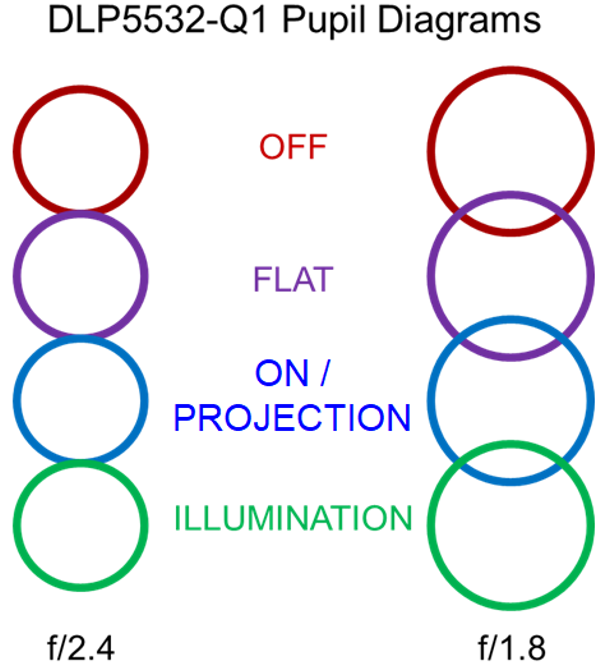DLPA129 March 2022 DLP3020-Q1 , DLP5532-Q1
3 DLP Projector Design Considerations
The Gauzy PDLC Smart Glass film technology must be paired with a projector that outputs a high amount of luminous flux to create a bright display at the surface of the film. DLP technology from TI enables a projector that offers high performance features for this application, such as high optical efficiency, high resolution, and constant performance across the automotive temperature range. At the core of DLP technology is the digital micromirror device (DMD), a two-dimensional array of millions of micromirrors that reflect the illumination source (LEDs or laser diodes). Each micromirror tilts in two states—on and off—using pulse width modulation (PWM) over the course of the video frame in order to create gray-scale pixel content in the final image. TI currently offers one DMD that is intended specifically for window display applications: DLP5532-Q1. This device has a larger micromirror array size and therefore can output higher optical power levels. A projector design from TQ Technology based on the DLP5532-Q1—illuminated by Luminus’s PTM-50X RGB LEDs—is considered for the purpose of this paper.
The PTM-50X series of RGB LEDs from Luminus is a great match for the DLP5532-Q1 DMD when targeting a bright window display application, enabled by specific projector design decisions. With any DMD-based projector, there is an inherent tradeoff between the total luminous flux throughput and the expected contrast of the projector. This relationship can be understood by referring to Figure 3-1 and Figure 3-2, which shows diagrams of the optical cones around the illumination of a standard DMD-based projector.
 Figure 3-1 Illumination Diagram of
Standard DLP Projector
Figure 3-1 Illumination Diagram of
Standard DLP ProjectorFigure 3-2 is called a pupil diagram that looks at the different optical cones surrounding the DMD. The main thing to note is that a high contrast system has separation between the on-state cone and the surrounding cones.
 Figure 3-2 Pupil Diagram of DLP5532-Q1
Projector at f/2.4 and f/1.8 Aperture Sizes
Figure 3-2 Pupil Diagram of DLP5532-Q1
Projector at f/2.4 and f/1.8 Aperture SizesFor the DLP5532-Q1 device with an on/off tilt angle of ±12°, a standard f/# for the projector apertures is f/2.4. This results in a pupil diagram where there is no overlap between the flat-state and on-state pupils. Flat-state refers to any light reflecting off flat surfaces such as the DMD coverglass. When pixels are tilted to the off-state position, the undesired flat-state light does not enter the projection lens pupil and thus leads to strong contrast performance.
However, the window display application is less sensitive to the contrast performance from the projector; rather the contrast of the final image is more impacted by the sunlight’s interaction with the screen material and the ambient environment. Therefore, for this application it can be recommended to expand the size of the aperture to f/1.8, as shown in Figure 3-2. This pupil expansion has a compounding effect for the DLP5532-Q1 and PTM-50X projector: the larger illumination cone is able to accept light from a larger LED. Since LEDs are often rated by their current density, a larger emission area is able to output more lumens. So, not only is there a higher throughput through the projector compared to a nominal f/2.4 projector, the LED itself will output more light as well. The tradeoff with f/1.8 aperture on a DLP5532-Q1 system is that there is now overlap between the on-state or projection lens pupil and flat-state light, which causes the contrast to decrease. As stated above, this tradeoff makes sense for vehicle window advertisement applications as the display is viewed at a distance.
Table 3-1 summarizes the optical performance of this DLP5532-Q1 and PTM-50X projector at f/1.8, showing that nearly 1,000 lumens are sent to the film. The projector optical efficiency is a measure of how much of the optical power from the LED is output from the projection lens to the first surface of the transparent window glass. The optical design of DMD-based projector is well-documented in the projector industry, and most display projectors designs have similar transmission performance [5].
| Projector Configuration | Specification | Value |
|---|---|---|
| DMD: DLP5532-Q1 RGB LED: PTM-50X Projector aperture: f/1.8 |
Electrical Input Power to LEDs | 75 W |
| Optical Efficiency of Projector | 24% | |
| Optical Output of Projector | 1,000 lm | |
| Optical Efficacy | 13.3 lm/ W | |
| Projector Contrast (FOFO) | 600:1 |